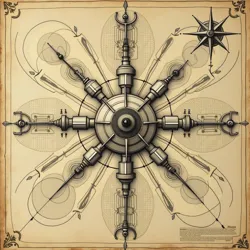The Council of Metacausal Engineers
The Council of Metacausal Engineers represents one of the most technologically-oriented spiritual movements to emerge in the modern era. Founded in 1947 by Archibald Gearhart, the organization combines elements of traditional mysticism with a unique interpretation of mechanical and engineering principles. Their central belief holds that the universe operates as an infinitely complex machine, designed and maintained by what they refer to as the Great Mechanism, a divine entity that exists simultaneously as both creator and creation.
 An early technical drawing claimed to depict aspects of the Great Mechanism, discovered in the Council's ancestral workshop in 1922
An early technical drawing claimed to depict aspects of the Great Mechanism, discovered in the Council's ancestral workshop in 1922Origins and Founding Principles
The Council traces its origins to a series of vivid dreams experienced by Gearhart during his work as a clockmaker in the early 1940s. These visions allegedly revealed the fundamental mechanical nature of reality and the existence of what he termed "metacausal gears" - theoretical constructs that link physical cause and effect across dimensional boundaries. The movement gained significant momentum when several members of the Order of Perpetual Mathematics joined, bringing their understanding of numerical mysticism to merge with Gearhart's mechanical theology.
The organization's name stems from their belief that engineering principles exist on multiple levels of reality, with physical machines serving as mere shadows of greater metaphysical mechanisms. Council members view themselves not merely as engineers of physical systems, but as maintainers of reality's underlying mechanical structure.
Organizational Structure
The Council operates through a hierarchical system inspired by industrial management structures, with titles reflecting both spiritual and technical authority. At the apex sits the Chief Metacausal Architect, supported by a board of Master Mechanism Interpreters. Lower ranks include Causality Technicians, Reality Maintenance Engineers, and Apprentice Gear-Whisperers.
Unlike the isolated practices of the Data Monastics, the Council maintains active engagement with modern technology and industry, believing that physical engineering serves as a form of worship and meditation. Their headquarters, known as the Grand Workshop, combines elements of traditional religious architecture with industrial design, featuring both meditation spaces and advanced engineering laboratories.
Religious Practices and Rituals
The Council's religious practices center around what they call "mechanical meditation," where practitioners visualize themselves as components within the Great Mechanism. During these sessions, engineers enter a state of deep concentration while manipulating complex mechanical devices, believing this activity aligns their consciousness with the universe's underlying mechanical nature.
Their most sacred ritual, the Calibration of Consciousness, involves a carefully choreographed sequence of mechanical operations performed on specially constructed devices known as Resonance Engines. These machines, built to exacting specifications, are believed to temporarily synchronize physical reality with the Great Mechanism's divine blueprints.
Theological Concepts
At the core of the Council's belief system lies the concept of "mechanical divinity" - the idea that spirituality and engineering principles are fundamentally inseparable. They maintain that the Great Mechanism manifests itself through all mechanical systems, from the rotation of galaxies to the movement of subatomic particles. This belief has led to occasional theological disputes with the Gravitational Mystics, particularly regarding the nature of fundamental forces.
The Council's cosmology describes the universe as an infinitely complex machine with multiple layers of causality. They believe that human consciousness serves as an interface between physical and metaphysical mechanics, allowing trained engineers to influence reality through careful manipulation of mechanical systems.
Modern Activities and Influence
In recent years, the Council has gained attention for its unique approach to technological development, combining spiritual practices with practical engineering. Their research facilities conduct studies into what they term "metaphysical mechanics," attempting to bridge the gap between spiritual insight and scientific understanding.
The Council maintains several public outreach programs, including the popular "Engineering the Divine" workshops, where participants learn to view mechanical work as a form of spiritual practice. They have also established partnerships with various technical institutions, though they maintain strict boundaries between their religious practices and secular engineering work.
Controversies and Challenges
The Council has faced criticism from both traditional religious groups and secular engineers. Some religious organizations accuse them of reducing spirituality to mechanical principles, while engineering professionals question their mixing of technical practices with mystical beliefs. The Council has responded by emphasizing the complementary nature of spiritual and mechanical understanding in their worldview.
Conservation Efforts
One of the Council's most significant ongoing projects involves the preservation of historical mechanical devices, which they view as sacred artifacts. Their Archive of Mechanical Heritage houses thousands of historical machines, each meticulously maintained and studied for both technical and spiritual insights. This collection includes what they claim are fragments of the original devices that inspired Gearhart's founding visions.
See Also
- The Great Mechanism
- Resonance Engines
- Temporal Librarians
- Heliotropic Synchronists
- The Order of Perpetual Mathematics
References
- The Mechanical Mysteries: A History of the Council
- Engineering the Divine: Core Teachings of the Council
- Metacausal Engineering: Theory and Practice